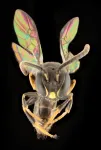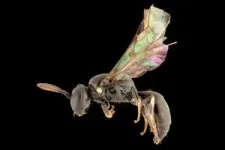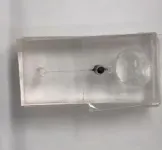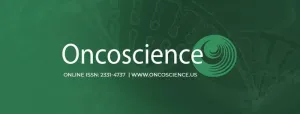(Press-News.org) In 1934, American entomologist Elwood Zimmerman, then an undergraduate student at Berkeley, participated in the ‘Mangarevan expedition’ to Polynesia. Among the samples he collected were three tiny (4 mm long), orange-brown solitary bees found on tahetahe flowers in the Tuamotu Archipelago.
The specimens rested undisturbed in the Bernice P Bishop Museum of Honolulu until 1965, when the famous bee specialist Prof Charles Michener examined them. He described them as a species new to science: Hylaeus tuamotuensis, or Tuamotu’s masked bee, in the family Colletidae.
How these tiny bees had reached French Polynesia was a mystery: its nearest known relatives lived in Australia, New Guinea, and New Zealand, more than 3,000 km west of Tuamotu. What’s more, the new species had never been collected again and was feared extinct – until the present day.
Now, 59 years later, the puzzle has been answered in a new study published in Frontiers in Ecology and Evolution.
“Here we show that, despite almost a decade of sampling for bees in Fiji, there is a whole group of species that flew right over our heads until now. By exploring new sampling techniques, we discovered an unknown species radiation of Hylaeus masked bees in the forest canopy,” said Dr James Dorey, a lecturer at the University of Wollongong and an adjunct lecturer at Flinders University and lead author of the study.
“With these bees we can solve the mystery: the ancestors of H. tuamotuensis reached French Polynesia by island-hopping via Fiji and the southwest Pacific!”
New to science
There, the team of authors describe eight new species of Hylaeus, discovered between 2014 and 2019 in the Pacific and shown by DNA barcoding and morphology to be relatives of Tuamotu’s masked bee – no longer an anomaly.
Six of the newly discovered species are from the Fijian archipelago: named the straight-faced, little yellow-spotted, and Navai’s Hylaeus from the island of Viti Levu, and the white-spotted, open-faced, and veli’s Hylaeus from Taveuni. Chuuk’s Hylaeus was discovered on Chuuk in the Federated States of Micronesia, and the golden-green Hylaeus on Tahiti in French Polynesia, 450 km southwest of Tuamotu.
The team were only able to discover the new species by sampling from the tree canopy on these islands. Previous sampling efforts had focused on flowering plants at ground level, which the new species seem to avoid. Also surprising was that that the new species seem to prefer red flowers, as the sensitivity of most bees to red light is poor.
“It wasn’t until we brought very long nets to Fiji and started collecting from the trees that we started to find our mysterious little bees. Maybe we should not be surprised when the etymology of Hylaeus might mean ‘belonging to the forest’,” said Dorey.
More discoveries expected soon
Hundreds of islands lie between Fiji and French Polynesia, for example Tonga, Samoa, the Cook Islands, and Wallis and Futuna. Now that the scientists know to look for them in the canopy, they expect to discover many more Hylaeus species on those islands.
But how did the bees hop between islands? Their typical flight range is unknown, but likely only a few kilometers.
“Because most masked bees nest in wood, it’s likely that they rafted between islands, especially when tropical cyclones wash masses of plant materials down rivers and out to sea. It is also possible that they were blown by high winds, but that would have been a much more perilous journey for our little bees,” said Dorey.
Guardians of the forests
How long ago these dispersal events happened can’t be resolved yet from the available DNA data. Nor do the authors know how common the new species are on the islands to which they appear to be endemic.
“[We named veli’s Hylaeus] for the veli of Fijian folklore who are powerful little people associated with forests. Accounts of the veli are varied and they were often seen in a positive light, but they could also be dangerous, for example, if you chopped down their favorite trees. Hence, the name is meant to invoke a sense of responsibility for protecting these new forest-specialist species and their trees,” reminded the authors.
END
How did a tiny bee get to French Polynesia? Eight new species help solve a scientific mystery
Scientists discover a previously unknown species radiation of masked bees, restricted to the tree canopies of Pacific islands
2024-02-26
ELSE PRESS RELEASES FROM THIS DATE:
Many older adults receiving home care do not receive palliative care before death
2024-02-26
Many older adults receiving home care do not receive any palliative home care before death, suggesting we need better methods to identify people who need this support, according to new research in CMAJ (Canadian Medical Association Journal) https://www.cmaj.ca/lookup/doi/10.1503/cmaj.221513.
"Palliative care is an essential component of a holistic, comprehensive and patient-centred approach to care for all people with a life-limiting illness from the time of diagnosis with the disease," said Dr. Amy Hsu, investigator at the Bruyère Research Institute and faculty in the Department of Family Medicine at the ...
Reforestation schemes are not enough to recover the carbon created by harvesting wood, research suggests
2024-02-26
Forests have a critical role to play in capturing and storing carbon from the Earth’s atmosphere – but some models exaggerate their carbon removal potential by almost three-fold, according to a leading professor of forest economics.
Global Forest Carbon: Policy, Economics and Finance by Runsheng Yin from Michigan State University emphasizes the value of nature-based solutions to the climate crisis but calls for significant changes to the way carbon credits from reforestation, afforestation, and improved forest management are calculated. He has found that current modeling of local ...
Antidepressant dispensing to adolescents and young adults surges during pandemic
2024-02-26
Antidepressant dispensing to adolescents and young adults increased sharply after the COVID-19 pandemic began – particularly among females – a new study finds.
While a growing number of young people ages 12 to 25 were receiving antidepressants before the pandemic, the antidepressant dispensing rate rose nearly 64% faster after March 2020, according to Michigan Medicine led findings in Pediatrics.
“Antidepressant dispensing to adolescents and young adults was already high and rising before ...
Healthcare leaders plea to reinstate the Canadian hypertension control program to prevent death and disability
2024-02-26
Philadelphia, February 26, 2024 – A passionate plea for the re-establishment of Canada's health coalition focused on hypertension prevention and control appears as an editorial in the Canadian Journal of Cardiology, published by Elsevier. "We need a national hypertension control program to prevent death and disability," according to prominent healthcare leaders.
Lead author of the editorial Norm R.C. Campbell, MD, Department of Medicine, University of Calgary, explains, "Hypertension is a leading cause of death and disability in Canada; globally it causes about one in five deaths (19.2%). However, ...
Drug limits dangerous reactions to allergy-triggering foods, Stanford Medicine-led study of kids finds
2024-02-25
A drug can make life safer for children with food allergies by preventing dangerous allergic responses to small quantities of allergy-triggering foods, according to a new study led by scientists at the Stanford School of Medicine.
The research will be published Feb. 25 in the New England Journal of Medicine. The findings suggest that regular use of the drug, omalizumab, could protect people from severe allergic responses, such as difficulty breathing, if they accidentally eat a small amount of a food they are allergic to.
“I’m excited that we have a promising ...
Measuring the properties of light: Scientists realise new method for determining quantum states
2024-02-25
Scientists at Paderborn University have used a new method to determine the characteristics of optical, i.e. light-based, quantum states. For the first time, they are using certain photon detectors - devices that can detect individual light particles - for so-called homodyne detection. The ability to characterise optical quantum states makes the method an essential tool for quantum information processing. Precise knowledge of the characteristics is important for use in quantum computers, for example. The results have now been published in the specialist journal "Optica Quantum".
"Homodyne detection is a method frequently ...
For faster access to gene and cell therapies in Europe
2024-02-25
Gene and cell therapies are among the most important innovations in the healthcare sector. And they reflect advances in science and technology. They have the potential to radically reshape the treatment of cancer, autoimmune diseases, neurodegenerative disorders, and many rare genetic conditions. But the path to approval and clinical use of these products is long and often fraught with difficulty.
That was the reason the European University Hospital Alliance (EUHA) founded the European Center for Cell and Gene Cancer Therapies (EUCCAT) four years ago. The center’s aim is to facilitate the clinical use of ATMPs developed at higher education institutions and further ...
Scientists deliver portable total chemical analysis without pumps and tubes
2024-02-24
Tokyo, Japan – Researchers from Tokyo Metropolitan University have engineered a new micro total analysis system that quantifies a target chemical in a microfluidic chip without pumps, tubes, and expensive detectors. The compound reacts with other chemicals to produce a gas, pushing ink in a connected chamber along a channel. Built-in light detectors help measure the flow speed, allowing measurement of the original chemical. The portability of the new device enables bedside, quantitative clinical analysis.
Microfluidics is a revolutionary technology delivering precision chemistry with vastly less chemicals. ...
A very long, winding road: Developing novel therapeutics for metastatic tumors
2024-02-23
“Given that the MET inhibitor capmatinib caused a remarkable response in Dr. Blagosklonny, a pertinent question remains as to why he was not treated with ‘preemptive drug combinations’ [...]”
BUFFALO, NY- February 23, 2024 – A new editorial paper was published in Oncoscience (Volume 11) on February 9, 2024, entitled, “A very long and winding road: developing novel therapeutics for metastatic tumors.”
In this editorial, researcher Paul Dent from the Department of Biochemistry and Molecular Biology at Virginia Commonwealth University writes that tumors that ...
Unlocking health: How In Our DNA SC is pioneering genetic screening for South Carolinians
2024-02-23
Physicians and scientists have known for many years that our genetics not only shape our physical features like our smiles but also our risk for developing certain diseases.
The problem? Most people don’t know if they have inherited these genetic risk factors for disease.
In Our DNA SC, a statewide genomic screening program launched by the Medical University of South Carolina (MUSC), aims to change that.
The program, the first and only program of its kind in the Southeast, is led by Caitlin G. Allen, Ph.D., a ...
LAST 30 PRESS RELEASES:
New expert guidance urges caution before surgery for patients with treatment-resistant constipation
Solar hydrogen can now be produced efficiently without the scarce metal platinum
Sleeping in on weekends may help boost teens’ mental health
Study: Teens use cellphones for an hour a day at school
After more than two years of war, Palestinian children are hungry, denied education and “like the living dead”
The untold story of life with Prader-Willi syndrome - according to the siblings who live it
How the parasite that ‘gave up sex’ found more hosts – and why its victory won’t last
When is it time to jump? The boiling frog problem of AI use in physics education
Twitter data reveals partisan divide in understanding why pollen season's getting worse
AI is quick but risky for updating old software
Revolutionizing biosecurity: new multi-omics framework to transform invasive species management
From ancient herb to modern medicine: new review unveils the multi-targeted healing potential of Borago officinalis
Building a global scientific community: Biological Diversity Journal announces dual recruitment of Editorial Board and Youth Editorial Board members
Microbes that break down antibiotics help protect ecosystems under drug pollution
Smart biochar that remembers pollutants offers a new way to clean water and recycle biomass
Rice genes matter more than domestication in shaping plant microbiomes
Ticking time bomb: Some farmers report as many as 70 tick encounters over a 6-month period
Turning garden and crop waste into plastics
Scientists discover ‘platypus galaxies’ in the early universe
Seeing thyroid cancer in a new light: when AI meets label-free imaging in the operating room
Neutrophil-to-lymphocyte ratio may aid risk stratification in depressive disorder
2026 Seismological Society of America Annual Meeting
AI-powered ECG analysis offers promising path for early detection of chronic obstructive pulmonary disease, says Mount Sinai researchers
GIMM uncovers flaws in lab-grown heart cells and paves the way for improved treatments
Cracking the evolutionary code of sleep
Medications could help the aging brain cope with surgery, memory impairment
Back pain linked to worse sleep years later in men over 65, according to study
CDC urges ‘shared decision-making’ on some childhood vaccines; many unclear about what that means
New research finds that an ‘equal treatment’ approach to economic opportunity advertising can backfire
Researchers create shape-shifting, self-navigating microparticles
[Press-News.org] How did a tiny bee get to French Polynesia? Eight new species help solve a scientific mysteryScientists discover a previously unknown species radiation of masked bees, restricted to the tree canopies of Pacific islands






